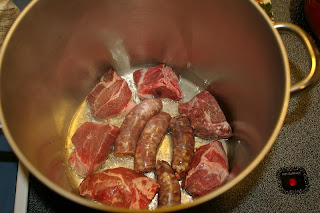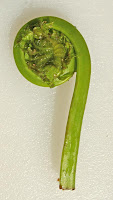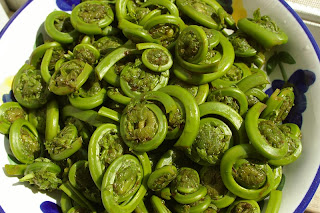
Wednesday, May 20, 2009
First Harvest!
We had our first salad from our garden the other day. A nice mix of leafy lettuce, arugula, and baby Swiss chard. Sixty-three days from seed to table.


Sunday, May 17, 2009
Sunday Gravy
 Despite my French-Canadian last name, my cultural heritage is actually Italian (or more accurately, Italian-American), on my mom's side. As a kid, I had no idea that it wasn't "normal" to have lasagna at Easter, calamari and scungilli on Christmas Eve (and manicotti and meatballs on Christmas Day), or at least two dozen people over for Sunday dinner (including any number of "cousins" and "uncles"). Linda's given up trying to figure out who's who ("Is that Big Joe or Little Joe?" "Neither, that's Anthony's son Joe" "Big Anthony or Little Anthony?" "Little Anthony, Big Joe's brother" "And who's that over there?" "That's Anthony, Little Joe's brother." ). My Nonna seems to always be cooking something and none of us grandkids are ever in danger of starving at her house, which was right down the street from where I grew up - a street which within a mile lived us, my grandparents, one of my aunts and her family, my uncle and his family and my mom's cousin (who was like my aunt). It took me a while to learn that when most kids referred to their "family" they meant just mom, dad and sis.
Despite my French-Canadian last name, my cultural heritage is actually Italian (or more accurately, Italian-American), on my mom's side. As a kid, I had no idea that it wasn't "normal" to have lasagna at Easter, calamari and scungilli on Christmas Eve (and manicotti and meatballs on Christmas Day), or at least two dozen people over for Sunday dinner (including any number of "cousins" and "uncles"). Linda's given up trying to figure out who's who ("Is that Big Joe or Little Joe?" "Neither, that's Anthony's son Joe" "Big Anthony or Little Anthony?" "Little Anthony, Big Joe's brother" "And who's that over there?" "That's Anthony, Little Joe's brother." ). My Nonna seems to always be cooking something and none of us grandkids are ever in danger of starving at her house, which was right down the street from where I grew up - a street which within a mile lived us, my grandparents, one of my aunts and her family, my uncle and his family and my mom's cousin (who was like my aunt). It took me a while to learn that when most kids referred to their "family" they meant just mom, dad and sis.Anyways, I digress. The point here is that much of my way of thinking about food comes from this upbringing. For me, family and food have always been abundant and inseparable. And no more so than on Sundays, when my Nonna or my mom would prepare the gravy. Now, I can't say with certainty that we had gravy every Sunday, but Sunday gravy was certainly the norm.
Yes, I said gravy. No, it's not the stuff you put on turkey at Thanksgiving (that's "brown gravy") and it's not the stuff that goes on biscuits (I don't know what that is). It's a red sauce. It's tomato-based. But it's not "tomato sauce" or even "spaghetti sauce". It's certainly not "marinara sauce" and you can't buy it at Stop & Shop. It may or may not involve meatballs, but always includes some kind of meat (usually pork and/or sausage, occasionally steak, rarely chicken). We always had it with macaroni - which meant ziti or penne or rigatoni - crusty bread, a salad, and red wine. The recipe that follows is not really a recipe so much as a template for making gravy - there aren't really any quantifiable amounts for the most part (though I'll try to ad lib some). This is what happens when the recipe comes from my Nonna - I don't think I've ever heard her use the words teaspoon or quarter cup. "How much oil, Nonna?" "Enough." "How long do you simmer it?" "Until it's done." "How do you know when it's done?" "You know." So, you just do it. And it comes out good, but never quite like hers. Because you never do it quite like she does - mostly because she doesn't tell you everything. Not out of spite of course, but because there are things that she assumes everyone already knows about cooking - for her it's second nature (maybe even first nature) and she doesn't realize that it's not like that for everyone (so actually, she doesn't even assume you know - not knowing isn't even a possibility). We always joke about strapping a camera to her forehead so we can record every single step. Even then, I'm sure we'd miss something.
Since I no longer live right down the street (though we're still just 40 miles away), I've started making Sunday gravy more and more myself. It's a slow food - you need several hours to do it right - so Sundays are good for it. Of all the recipes on this blog, this one is the most important. Sunday gravy is what this blog is all about - paying attention to what and how we eat. Gravy is about food, family, and tradition, and taking the time to appreciate them all. Of all the meals that I make, this is the one that connects me to my Nonna, my mom, and my aunts and one that I hope Emma and Jack will be calling me (or their Nonna) for advice on when they grow up.
(Generally, with this recipe, I cook a pound of macaroni, which is more than enough for the four of us, with leftovers. I also end up with a few cups of gravy that I freeze for another day. Adjust according to your needs, though I'd hesitate to go any smaller. Also, for the meat you can mix and match any number of cuts of pork, beef, and sausage - just be sure that it is fatty enough to take a long braising without drying out. Meatballs are another post.)
Macaroni and Gravy
~1 lb Italian sausage (hot and/or sweet)
~1 lb boneless "country style" pork ribs
2 28oz cans crushed tomatoes (I use Pastene brand, "Kitchen Ready" tomatoes)
1 medium onion, sliced
red wine (maybe a 1/2 cup?)
vegetable oil (olive oil will burn too quickly)
salt
pepper
red pepper flakes (optional)
- Heat oil over medium heat in large stock pot (be generous with the oil)
- Brown pork and sausage, turning occasionally, about 20 minutes
- While browning add onion, salt, pepper, and red pepper flakes (if using)
- Deglaze with red wine, scrapping the bottom of the pan
- Add tomatoes
- Rinse tomato cans with about an inch of water each and add to the gravy (this is one of those things Nonna doesn't tell you about - you just catch her doing it one day and when you tell her that she never told you about it, she replies, "Of course you do that!")
- Continue to cook on medium heat for 20-30 minutes, stirring occasionally (make sure that you've rigorous bubbling, but be careful not to scorch the bottom)
- Reduce heat; simmer for at least 2 hours, 4 hours would be much better; stir occasionally
(you should notice a change in color, sheen, and consistency over the hours - darker, shinier, thicker. I actually gradually reduce the heat over the hours) - Remove meat to separate bowl
- Serve over macaroni, with meat on the side







Wednesday, May 13, 2009
Fiddleheads
 Talk about the ultimate in eating seasonally and locally! Fiddleheads, the unfurled fronds of the ostrich fern (Matteuccia struthiopteris) , are available for only a few weeks in the Spring and, as far as I know, are not cultivated, but harvested wild. You have to be in the right place at the right time. Luckily for us, New England is the right place and right now is the right time. So, as part of Linda's birthday supper, I decided to cook up a batch.
Talk about the ultimate in eating seasonally and locally! Fiddleheads, the unfurled fronds of the ostrich fern (Matteuccia struthiopteris) , are available for only a few weeks in the Spring and, as far as I know, are not cultivated, but harvested wild. You have to be in the right place at the right time. Luckily for us, New England is the right place and right now is the right time. So, as part of Linda's birthday supper, I decided to cook up a batch. Fiddleheads are a rather mild, earthy vegetable - something akin to asparagus. They lend themselves to a variety of preparations - boiled, steamed, sauted - and can take just about any type of seasoning or sauce. Before you cook them however, they should be thoroughly washed to remove the brown papery "scales" (I wonder what the botanical term is), dirt, and grit. Ends should be trimmed.
For tonight's dinner, I blanched the fiddleheads in salted, boiling water for about 2 minutes, then shocked them in ice water, drained, and allowed to air dry. I then sauted them in olive oil with some garlic and salt until just tender, deglazed in a splash of white wine and finished by tossing them with a balsamic vinaigrette (and I intended, but forgot, to serve them with a dash of red pepper flakes and some fresh-grated parmesan). They were the perfect complement to the grilled rib eye and Israeli couscous with Swiss chard.




Subscribe to:
Posts (Atom)